
| Home | Locations | Prices | About Me | Links | Contact Info |
Phoenix Bat Removal
| My name is Joseph, and I specialize in the safe, humane, and effective removal of bats from buildings. I live in Phoenix, and operate throughout metropolitan area, and I have performed bat removal projects throughout the state of Arizona. Bat removal is specialty work, and experience matters. Not every company is the same. Some will do a terrible job, some will kill bats, some will leave bats to enter the living space of your home. Through my many years of experience, I have learned how to successfully remove 100% of the bats, without killing any, with a 100% success rate, and guarantee against re-entry. Give me a phone call any time, and we will discuss your bat problem in Phoenix. I can usually come to the property within a day to do a full inspection and give you a written price quote to permanently solve the bat problem. | 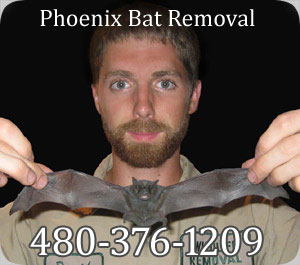 |
| We operate 24/7. We are fully licensed and insured. We offer a full written guarantee on our work, and provide a full range of services for all of your bat control needs, including full home repairs and bat prevention, and attic cleanup of bat guano. We are very familiar with and compliant with the state laws regarding bat removal in Arizona. |
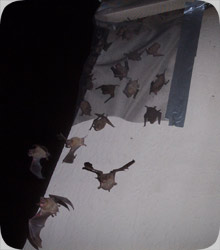 | Superior Bat Exclusion:
Not every company is the same. In fact, if you hire a regular pest control company here in Phoenix, one that deals with poisoning insects, they often cause disastrous results when
attempting bat removal work - they often try to poison the bats like bugs! Bats don't work that way. They must be excluded. Bats leave their roost (your home or building) every night to feed on insects. At that time, if you've properly
sealed all secondary exit points and properly installed one-way exclusion devices over the primary bat exit points, you can remove the entire colony. It's not quite as simple as that, but that the gist of it. Within 3 days, the entire
colony will be completely gone, and none of the bats killed or even injured. To the left is a photo of one type of exclusion technique for an extruded fascia board gap. Bats can enter buildings in so many different areas - dormers, vents, gables, soffiting, etc. Different exclusion devices and techniques are used for different architecture. |
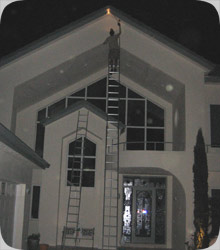 | Residential Homes: The majority of the cases of Phoenix bat removal involve the removal of small-medium colonies inside residential homes in the Phoenix area. The most common bat here is the Mexican Feetail Bat, which can form huge maternity colonies. Sometimes people don't notice the bats in the home when the colony is small, like 30 bats or less. At that size, they are fairly quiet, and the droppings haven't accumulated to a noticeable size to cause odor problems. However, bats live a long time, and each of the members in your attic (colonies are entirely female) will give birth to one young per year, so the size of the colony roughly doubles every year. And no, bats don't just go somewhere else. Once a colony is established, it will stay in that house year after year. Some do in fact migrate, depending on factors such as temperature and food sources, but even if they migrate out at a certain time of year, they will definitely return to your house again. We service all Phoenix homes, both big and small, and any type of roof, from shingle to tile. |
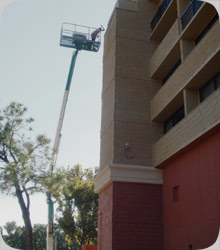 | Commercial Properties: Some bat removal jobs are large and challenging. We can remove bats from any possible structure. We have worked on all kinds of commercial
properties - from large apartment and condominium complexes, to shopping malls, hotels, parking garages, etc. Bats will live in very tall buildings, over 100 feet tall, in which case special equipment is necessary. We take great care in
ensuring that the bats are removed discreetly and safely, with top concern for your clients in mind. The liability risks of having a colony of bats living in a building, particularly health risks such as rabies or histoplasmosis, are
too high. We not only remove all of the bats from the building, but we fully clean and decontaminate the mess the bats have left behind. We carry the proper state licensing and liability insurance, and can provide references from other commercial bat control projects on request. Call me any time to schedule a building inspection and receive a complete proposal for the removal of bats from your building(s). |
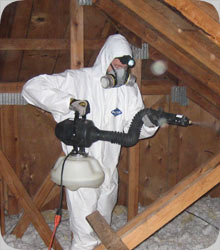 | Attic Decontamination: Bats leave behind a lot of feces (guano) when they inhabit a building. In most cases, there'll be mounds of bat droppings below popular roosting areas, and bat pellets scattered throughout the attic, and down the walls. The problem with the bat droppings is that they can grow mold which can cause lung diseases in humans. This is a biohazard risk, and so a building should be properly cleaned and decontaminated after all the bats have been removed. The droppings can also cause odor problems, so our cleaning technique not only kills all the mold spores and bacteria, but also eliminates the odor. We remove bulk bat guano and contaminated insulation, and light contamination by filter vacuum. We are able to remove the droppings from attics, walls, and anywhere it has accumulated. We use a special enzyme-based cleaner to fog the attic and wall voids, to kill all mold and pathogens, and kill the odor as well. Not only does the bat feces need to be addressed, but the urine that has soaked into wood, insulation, and other parts of the structure as well. attic cleanup info |
| We service the greater Phoenix area, and even the entire state of Arizona for larger bat exclusion projects. Some of the areas we commonly service include Scottsdale, Paradise Valley, Tempe, Glendale, Mesa, Gilbert, Chandler, Avondale, Sun City, Peoria, Surprise, Fountain Hills, and Sun Lakes. |

Why do bats like to live in buildings? Just like you and me, bats like someone warm and dry to call their home. They are nocturnal creatures which means that you are more than likely going to notice them flying in and out of a building right around dusk and dawn. At dusk they start to leave their roosts, firstly to find water where they will take a drink, then to enjoy their meal which will usually consist of moths, beetles and other forms of flying insects. Once they have enjoyed their feast, they will usually head back to the roost to sleep it off. This will continue on throughout the night and then at dawn, they will find their beds and sleep for the day.
In the wild, animals need very few things. They need to keep themselves safe from predators. They need somewhere warm and dry to lay their head. They need food and water to survive and finally, they need to reproduce. And building will offer all of these things to a passing bat.
The building will give more than enough shelter for the bat to avoid any predators. This is, of course, going to appeal to any animal that’s just trying to stay alive in the big bad world. If it can fly into the rafters of a building, it can find instant shelter from anything that might be chasing it. This is vital when it comes to rearing their young too – they need to have them in a place that is sheltered so that predators do not get their mouth around one of the babies. In order to survive in the world, you have to reproduce as many young as you can and when you have somewhere warm and dry to raise them, there is no better place.
A bat will think of your building (or any building) with almost the same eyes that you do. You wouldn’t go for a house that was drafty, cold, with no doors or windows to keep out intruders, and filled with water often. Why would you expect a bat to make that decision over the comfort and warmth of your house? It just doesn’t make sense, does it?
The other thing that you need to remember is that there is likely to be food readily available near your building. Insects fly around everywhere, especially in the warmer months, and this is even more so if you live anywhere near a stretch of water, mostly due to flying bugs like mosquitoes. As well and shelter from the elements and other animals, you may also be providing the bats with a source of food.
When you see bats in a building, you will find that they are mostly female bats. Males lead a more solitary life, choosing to sleep along in trees whereas the women, (as in most species) love to gather together. They will also rear their young here so if your home is a good enough place to squeeze in a whole of bats quite comfortably; you may want to start thinking about bat-proofing. This is even more so the case if the tops of your home tend to get very warm. If your attic could double as a green house in the warmer months, there is a good chance that you already have bats – they tend to love these warmer temperatures and actually thrive within them.
Most home owners will find that the odd bat living in their attic don’t normally cause much of a concern, but when you have a whole colony full, things can start to get a little messy, as well as very noisy and probably rather annoying.